The NVIDIA GeForce GTX 1080 & GTX 1070 Founders Editions Review: Kicking Off the FinFET Generation
by Ryan Smith on July 20, 2016 8:45 AM ESTGrand Theft Auto V
The latest edition of Rockstar’s venerable series of open world action games, Grand Theft Auto V was originally released to the last-gen consoles back in 2013. However thanks to a rather significant facelift for the current-gen consoles and PCs, along with the ability to greatly turn up rendering distances and add other features like MSAA and more realistic shadows, the end result is a game that is still among the most stressful of our benchmarks when all of its features are turned up. Furthermore, in a move rather uncharacteristic of most open world action games, Grand Theft Auto also includes a very comprehensive benchmark mode, giving us a great chance to look into the performance of an open world action game.
On a quick note about settings, as Grand Theft Auto V doesn't have pre-defined settings tiers, I want to quickly note what settings we're using. For "Very High" quality we have all of the primary graphics settings turned up to their highest setting, with the exception of grass, which is at its own very high setting. Meanwhile 4x MSAA is enabled for direct views and reflections. This setting also involves turning on some of the advanced redering features - the game's long shadows, high resolution shadows, and high definition flight streaming - but it not increasing the view distance any further.
Otherwise for "High" quality we take the same basic settings but turn off all MSAA, which significantly reduces the GPU rendering and VRAM requirements.


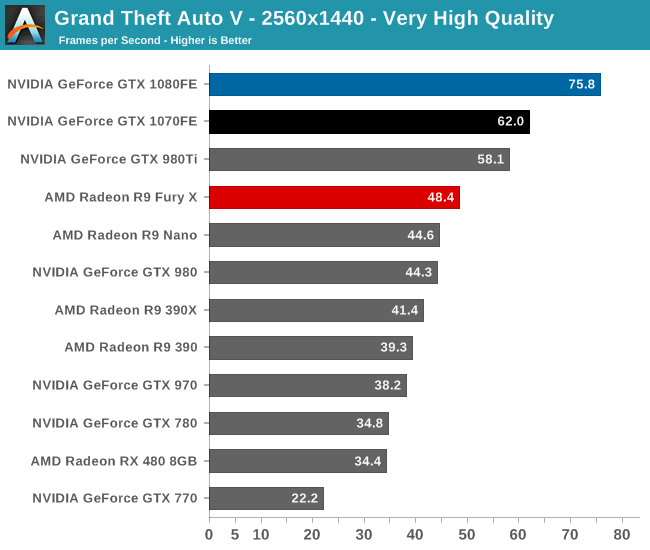
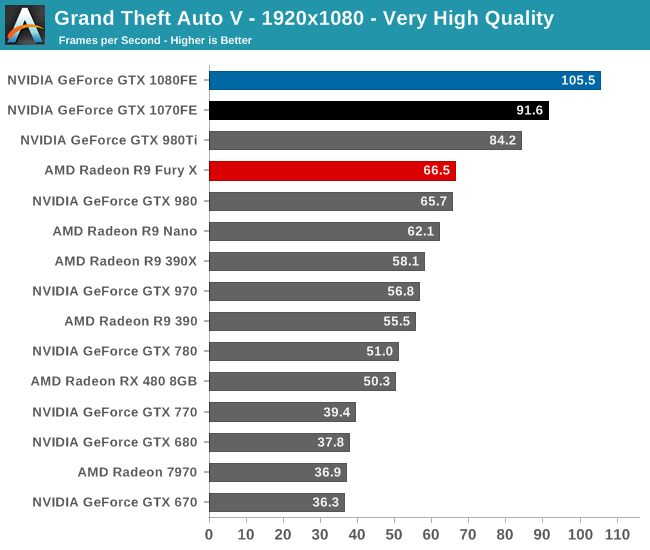
GTA V is another game that in recent times has favored NVIDIA GPUs, and as a result the GTX 1080 enjoys a solid standing here. At 61.4fps, the card becomes the first card to crack 60fps at 4K, albeit at only High quality. For very high quality, it becomes the first card to crack 30fps, both reinforcing how much of an improvement the card is over the previous generation and at the same time highlighting that it’s still going to have to make quality tradeoffs for 60fps at 4K.
Second to only the GTX 1080 is of course the GTX 1070. 4K is arguably out of the question, but at 1440p it can do just better than 60fps, making it the second card to do so. And though largely symbolic, it manages to do so when the GTX 980 Ti could not.
Looking at the generational improvements, GTA shows slightly better than average scaling with the new Pascal cards. GTX 1080 holds a anywhere between a 61% and 71% lead over the GTX 980, with particularly good gains above 1080p. Meanwhile GTX 1070 averages just shy of 60% over its GTX 970 counterpart.
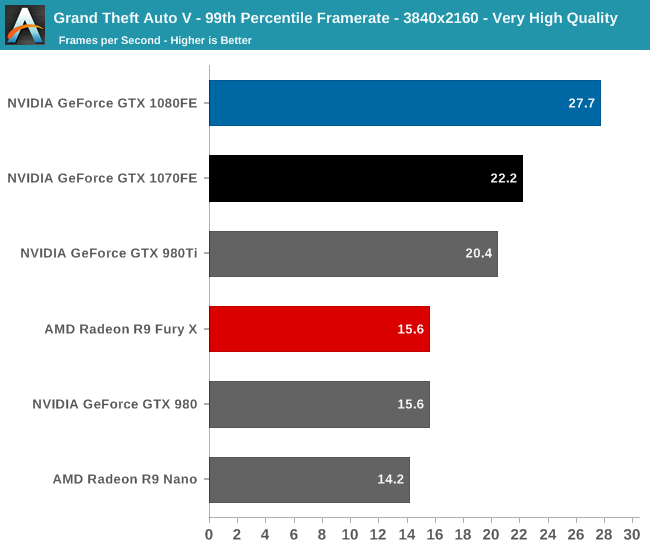
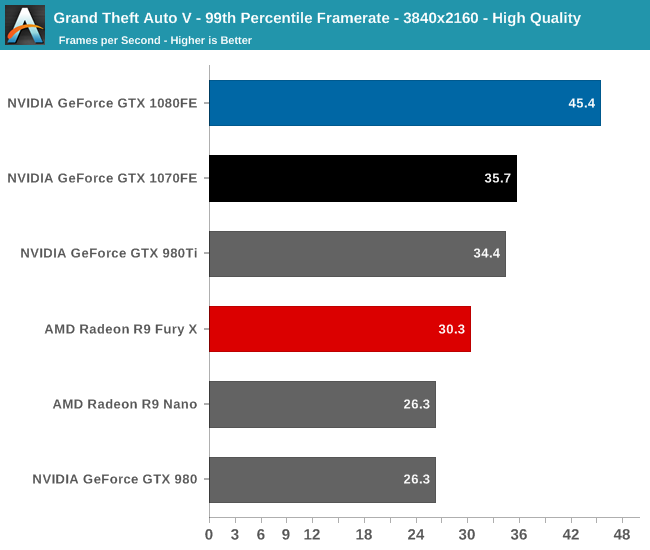
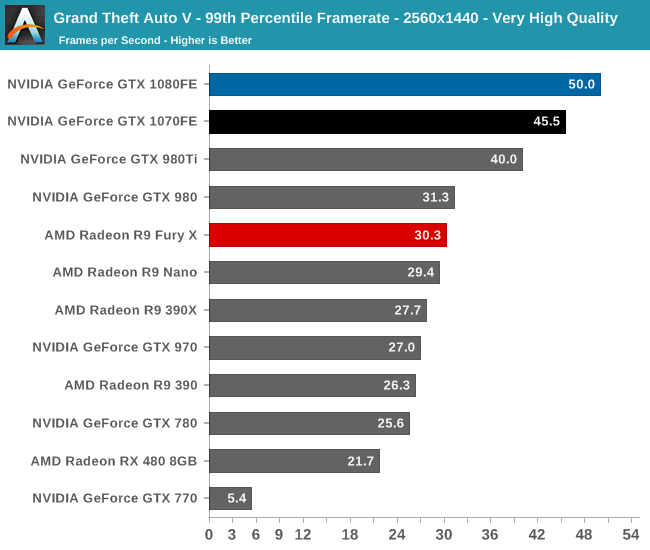
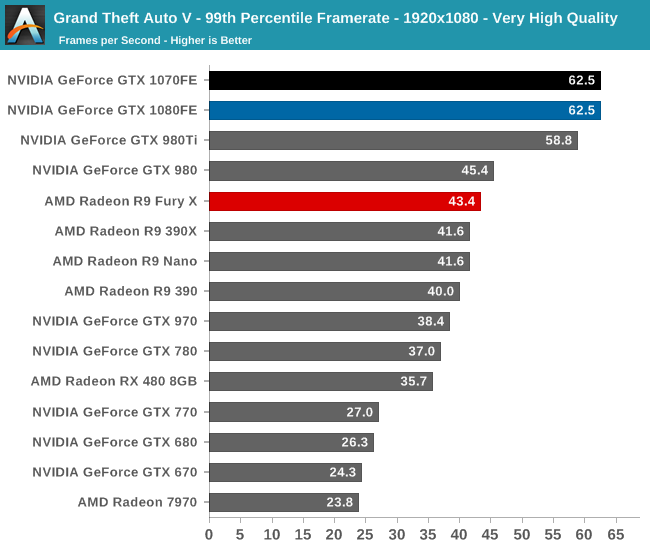










200 Comments
View All Comments
bill44 - Friday, July 22, 2016 - link
That's the problem. I know nothing about the 900 series audio capabilities (which I suppose is the same as the 800 series ;) ) and no one publishes them in review. All reviews are incomplete.Anyone here knows at least the supported audio sampling rates? If not, I think my best bet is going with AMD (which I'm shure supports 88.2 & 176.4 KHz).
bill44 - Saturday, July 23, 2016 - link
Anyone?poohbear - Wednesday, July 20, 2016 - link
thank you for the review, late as it is it's still an excellent review and love the details!junky77 - Wednesday, July 20, 2016 - link
In other reviews, even a Haswell-E is limited for GPUs like GTX 1070JamesAnthony - Wednesday, July 20, 2016 - link
I really appreciate all the work that went into this in depth review.I especially am very glad that you included the GTX 680 in the benchmarks along with all the other cards after it.
It's often really hard to get an overview of performance over a couple years.
I'm looking at upgrading 2 systems from GTX680 to either GTX 1070 or GTX 1060 and Titan (original one) to GTX 1080, so this helps see what the performance would be like.
Hopefully you tested the 1060 the same way so I can just plug the numbers for it into the same graph.
Thanks again!
Ryan Smith - Wednesday, July 20, 2016 - link
Be sure to check Bench. The 1060 results are already there, so you can see those comparisons right now.fivefeet8 - Wednesday, July 20, 2016 - link
2nd page 3rd paragraph: "generational increate in performance". ;increase?2nd page 2nd section: "Pascal in an architecture that I’m not sure has any real parallel on a historical basis". ;is?
hansmuff - Wednesday, July 20, 2016 - link
Great review, i like that you went into all the hardware details. Worth the wait.Chaser - Wednesday, July 20, 2016 - link
I'm a Nvidia guy all the way. For now. I am disappointed in the midrange RX480 and it's power consumption compared to the competition, especially after they had said that Polaris was goingto primarily be an efficiency improvement.Outside of my bias I truly hope AMD provides a very competitive flagship in the near future. Everyone wins. But with the 1060 now announced it just makes AMD's GPU prospects and profitability questionable.
MarkieGcolor - Wednesday, July 20, 2016 - link
So basically after all the hype about finfet, we get a standard, if not disappointing jump this generation also with a price hike. I'm so relieved that I didn't wait for this generation and can just enjoy my current 970 sli/nano crossfire rigs. AMD easily has the opportunity to blow these cards out of the water with big gpus.